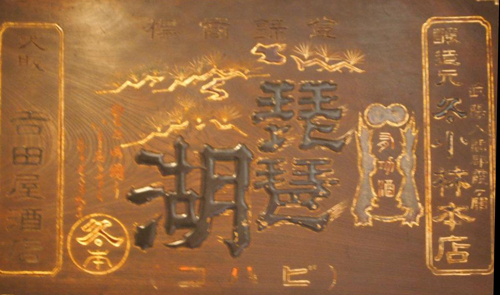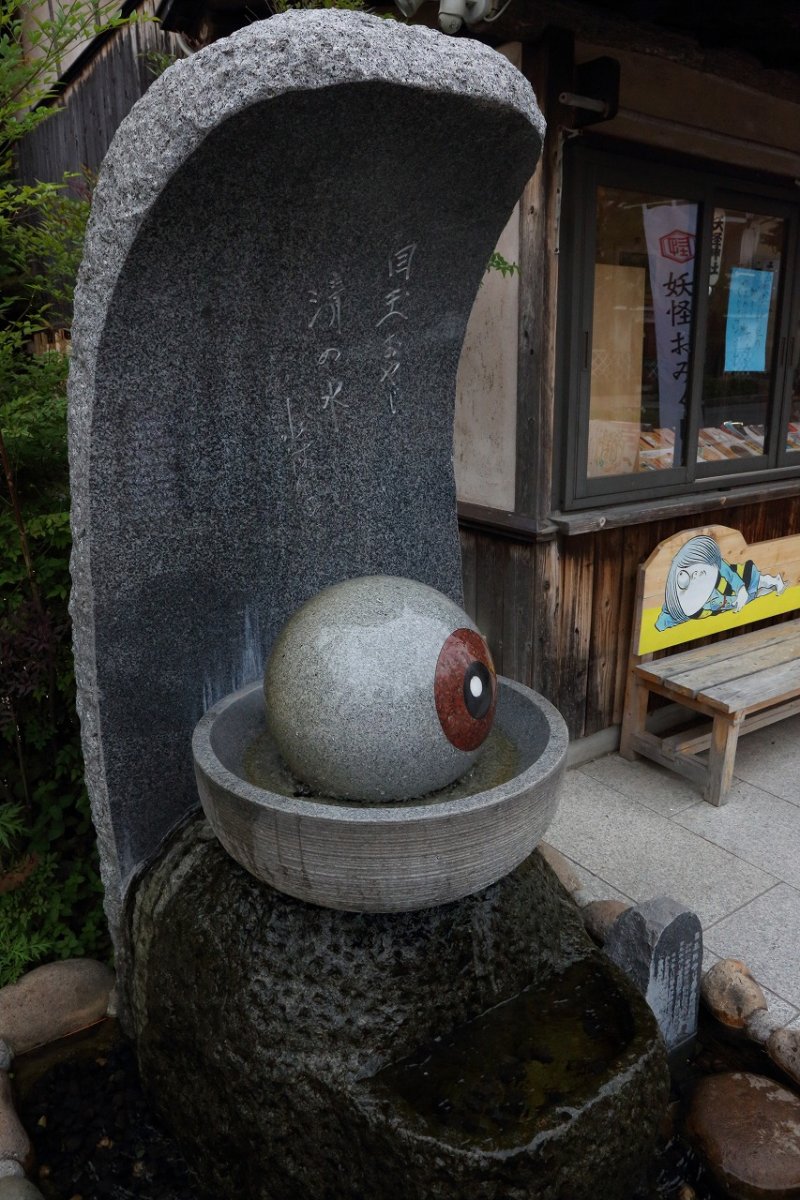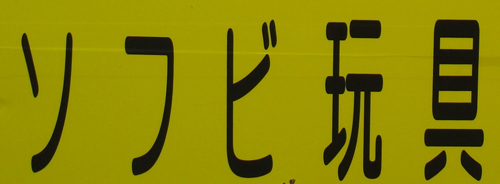96. The "Jewel" Radical: 玉 and 王
Awhile ago, the "jewel" radical tripped up me entirely. It happened when I looked at this photo on Facebook and tried to identify the two stacked characters in the center:

Photo Credit: Atsushi Otsuki
Sign for the Old Yoshida Saké Store.
Using a radical chart, I had no luck finding a radical to match these shapes. Finally I turned to my Facebook friend and asked for help.
She reminded me that in an old sign like this, we need to read from right to left (or, in this case, from upper right to lower right and then over to the left). Doing that yields this word:
琵琶湖(びわこ: Lake Biwa)
This freshwater lake in Shiga Prefecture (near Kyoto) is Japan's largest, and the saké store appears to have been named for it.
We should also read the katakana under the name from right to left, finding ビハコ. This old spelling corresponds to ビワコ (びわこ) today.
Both 琵 and 琶, which are non-Joyo, contain the radical 玉. No wonder I hadn't been able to identify it; that shape has an extra stroke that doesn't appear in these kanji, and it didn't occur to me to search for a radical more elaborate than what appeared in the characters.
As if I needed more proof that one really needs to know radicals in order to navigate the kanji world, here it was!
More Surprises with 玉
I had more surprises waiting for me.
I found that there's no etymological reason for 玉 to be in either character. According to a Japanese Wikipedia entry on this radical, the double 王 shapes on top originally represented the "strings" of a musical instrument. This helps to explain why both character mean "lute."
In the same vein, the double serving of 王 atop this Joyo kanji has nothing to do with kings but rather with strings:
琴 (1178: Japanese zither; stringed instrument; Western instrument)
That is, as Henshall explains in his newer edition, the 王 shapes initially represented the "strings" of the upright instrument.
Photo Credit: Eve Kushner
Off of Honshu, on Sado (佐渡, さど) Island, there's a place called 琴浦 (ことうら), where 浦 means "seaside; inlet bay."
The Etymologies of 玉 and 王
I found even more surprises when I examined Henshall's etymologies for the autonomous 王 and 玉 characters:
王 (5: king)
Henshall says that a more elaborate, early version of this shape depicted the "blade of a large battle ax." This character evolved to mean "powerful figure" and eventually "king."
玉 (102: gem, jewel; ball)
This was originally a pictograph of a "string of beads," ones probably made of jade, says Henshall. The initial shape resembled 串 but had an extra disc. (Kanjigen disagrees, presenting an early shape for this character that looks much more like キ with an additional bar.) "Ball" is an extended meaning.
Henshall's etymology of 玉 doesn't end there, but his next point is so crucial that I wanted to pull it out of a narrow etymology discussion and present it here. He says that 玉 acquired the extra point on the bottom right to distinguish it from 王 and that this stroke drops out in the radical 王.
Aha! On seeing this, I suddenly understood the following things:
• This is why it's called the "jewel" radical (or sometimes the "jade" radical), not the "king" radical!
• This is why the five-stroke 玉 is the parent and the four-stroke 王 is the variant.
• This is why nearly all the kanji with this radical represent something round. Except for 王 itself, these characters have no connection to anything regal, only to precious stones.

Photo Credit: Lutlam
A Japanese poster for the film The King's Speech features 王 (おう: king). It's alongside 国 (country), which contains 玉 as a component. How great to see these shapes next to each other! The word 英国 (えいこく) means "Great Britain" or "The United Kingdom."

Photo Credit: Kayoko Kurimoto
On the upper right, one can spot the faint word 目玉 (めだま: eyeball). The eyeball shown here represents a manga character with the nickname 目玉おやじ (めだまおやじ) as he takes a bath in a bowl. He's part of the manga series 「ゲゲゲの鬼太郎」where the last word is the given name きたろう.
Names and Positions of the Radical
The Japanese names of radical 96 depend on where it is in a kanji.
Here's what we can call the parent radical, 玉, along with the lone Joyo example:
たま
玉 (102: gem, jewel; ball)
And here are ways of referring to the variant, 王, along with examples of each:
たま or おう when the radical is located anywhere in a kanji:
王 (5: king)
琴 (1178: Japanese zither; stringed instrument; Western instrument)
たまへん or おうへん when the radical is on the left:
球 (257: ball, sphere)
環 (1115: ring, circle; to surround)
珠 (1349: pearl; gem; bead)
Because 王 is almost always on the left, we can primarily call this radical たまへん. Note that when 王 is in that position, its bottom stroke angles up to the right.
Photo Credit: Eve Kushner
In the phrase 環境にやさしい (gentle on the environment),
環境 (かんきょう: environment) begins with our star radical.
Photo Credit: Eve Kushner
A sign in Tokyo mentions
真珠 (しんじゅ: pearls).
Photo Credit: Eve Kushner
On a piece of cloth in a restaurant in Portland, Oregon, our radical appears three times!
To the right we find these words:
琉球 (りゅうきゅう: name of an island chain that includes Okinawa)
泡盛 (あわもり: awamori, a strong Okinawan liquor)
The 琉 kanji means "gem" and is non-Joyo. Is the Ryukyu island chain full of precious gems?!
The largest word again starts with a non-Joyo kanji, one that means "congratulations":
瑞泉 (ずいせん: name of an awamori brewery)
When a Kanji with the 王 Radical Doesn't Represent Something Round
We've seen that most kanji with the on-duty 王 radical represent something round. What about the ones that don't? Let's look at the anomalies in the Joyo set:
現 (666: actual; to appear)
Henshall says that the radical means "jewel" and that 見 means "to see." Together, they yield "to see a jewel," which has two associated meanings, including "being visible, appear."
理 (220: reason; basic principle)
Henshall says the radical means "jewel," whereas the 里 means "village" but also acts phonetically to express "split." Thus, 理 originally meant "to split a jewel," evolving to mean "to act carefully" and "concentration," leading to the idea of "using the mind" and therefore "reason(ing)."
班 (960: squad, group)
Here we have double the jewels, but not on top, as in 琴. In 班 the doubling means "many jewels" or "various jewels," says Henshall. The 刂 (sword) in the middle means "cut," which is to say "divide." The character 班 originally referred to a ruler who divided jewels and allotted them to various nobles. (This is very different from the idea of splitting jewels in the etymology of 理.) Two meanings spun off: "to allot" and "division," with "section" or "group" being an associated meaning.
珍 (1602: rare)
The radical means "jewel," says Henshall, and the right side stands for "person and hair." That right component also acts phonetically to express "pure, unblemished" and maybe "attractive." Putting it all together, we have "(attractive?) unblemished jewel," which is "rare."
玩 (1982: to play with; trifle with; fiddle with; take pleasure in; make fun of; relish; cherish)
Kanjigen doesn't explicitly say what the radical means here. Instead, it notes that the 元 is the pictograph of a "round human head"! When this component combines with the radical, we have "rolling a ball in rounded palms and enjoying the feeling"!
Photo Credit: Eve Kushner
A Nagoya restaurant offers Hong Kong cuisine: 香港料理 (ホンコンりょうり).
Our radical appears in the last kanji.
Photo Credit: Natalia Bourlot
A Japanese restaurant in Brazil is called 現代 (げんだい: modern times; nowadays).

Photo Credit: Kevin Hamilton
The word 玩具 (ソフビ がんぐ: "soft vinyl" toys) starts with our radical. Meanwhile, ソフビ is an abbreviation for ソフトビニール (soft vinyl), which can mean “plastic” (or more specifically "polyvinyl chloride," which is to say "PVC"). The Japanese often use ソフトビニール for materials in toys.
Photo Credit: Eve Kushner
This cake of puer tea features Chinese writing that contains two of our 王 kanji! On the upper left we have 班 (960: squad, group), which is in 班章茶. Beneath 班 we find 珍 (1602: rare). Rare indeed!
